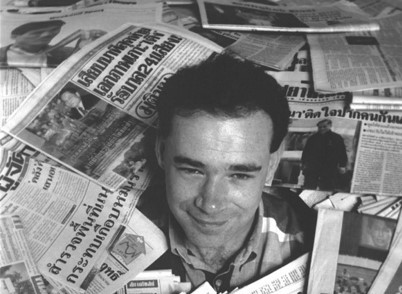Media and Thai Politics

Photo credit: John McDermott
Most of my work from 1994 to 2001 concerned the political role of the media in Thailand and several other countries in the Asia-Pacific region. This project was funded by a four-year fellowship from the Economic and Social Research Council (ESRC). The core of my fellowship was a year’s fieldwork in Thailand (1995-96), during which I conducted participant observation research inside the offices of five Thai-language news publications: Arthit, Thai Rath, Matichon, Phujatkan and Siam Post. I also spent a month shadowing parliamentary reporters during the collapse of the first Chuan Leekpai government. The Thai phase of the project resulted in my book Politics and the Press in Thailand: Media Machinations (Routledge 2000), later republished in a local edition (Garuda Press 2002) which enjoyed brisk sales in Bangkok.
The comment-based news gathering system, and the polemical character of most columnists, was designed to provoke slanging-matches rather than expose politicians and interest groups to serious critical scrutiny. Superb at generating political heat, Thai newspapers largely lacked the capacity to generate light (McCargo, Politics and the Press in Thailand).
I also conducted shorter periods of fieldwork in Indonesia, Japan and Hong Kong, culminating in my comparative companion volume Media and Politics in Pacific Asia (Routledge 2003). I have continued to publish on questions of language, media and communication in a number of subsequent articles, and in a widely-cited contribution on ‘partisan polyvalence’ to Dan Hallin and Paolo Mancini’s edited volume Comparing Media Systems Beyond the Western World (Cambridge 2012).
I have sought to problematize a number of prevalent assumptions about politics and media, notably that the media is typically an asset for processes of democratization and political reform. I argue that media partisanship is a complex phenomenon that cannot be reduced to favouring one political party or another. Understanding media companies through a political economy lens is often misleading, since many newspapers and media businesses are not profitable in a conventional sense: media owners are often focused on buying influence, rather than making money. Most censorship of media comes not from state actors, but from a range of other stake-holders.
Above all, it is important to recognize that the plurality of voices found in many media outlets does not necessarily reflect a culture of liberalism and free expression: rather, this partisan polyvalence is generally a strategic choice, a mechanism adopted by media proprietors to maximize their influence and help ensure their survival during times of political upheaval. I believe that most of the world’s media broadly resembles the Southeast Asian mode of partisan polyvalence, rather than the media models favoured by western scholars that are based around a very limited number of Anglo-American or European examples.
